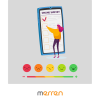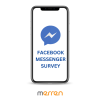Customers don’t want to answer surveys anymore. Certainly not any long, and boring online survey. Most surveys that land in the inbox these days have less than 5% open rate- i.e., less than 5 in a 100 would even bother to click the link and land on your survey web page. The completion rates are less than 0.5% and falling. Long story short, if you send 1000 invites, you will get 50 people who would reach your survey form and perhaps 5 would complete it.
Compare this to 17%+ completion rates that we have achieved at Merren. How? Here are some of the strategies that will bring you a higher response rate:
Reaching customers through the right medium improves survey response rate:
If you wanted to ask a hairdresser a question and you send them an email with a survey link, the chances are that they would not open it. They will certainly not open it at the workplace. They probably will forget about it once they get home at the end of the long workday. You send the same respondent a message on Facebook Messenger (or WhatsApp) or SMS, you are much more likely to get a response. Why? Because you used a low friction, always-on, low context switch (more on this in #2) medium. You can read more on why messaging apps outperform browser based survey here
In-context surveys get faster, better quality response:
Seeking response from your target audience without changing the “context” improves both open and completion rate and leads to better quality of response. Maintaining context works in two ways:
- Maintaining the mental context: Your customer has just interacted with your brand. Now you ask them a question where the experience with your brand is still fresh. In this case, you are more likely to get a response in the moment. Comparatively, if you ask them about the experience later in the day, the number of responses will have drastically dropped. Why? By now, the customer’s mental context has switched.
- Maintaining the medium context: When you send your customer an email survey, expecting them to click on a link which takes them to a browser, you are changing the customers’ (medium) context. Instead, if your customer could simply submit their response by completing the survey in the interactive email itself, the average response rate would be higher as there is no context switching

Conversational tone improves survey completion rates:
Customers prefer conversations over an intimidating questionnaire. Using conversations to collect information automatically enhances the online survey response rates. Small changes like below increase the survey response rate, sometimes potentially from non responders as well:
FROM : “Name”
To : “Hi, can you please tell me your name”
From : “Age”
To : “It’s nice to meet you <First Name>. Can I know your age?”
Splitting surveys into smaller, digestible pieces would improve survey completion rates:
This point probably deserves a whole post of its own. Long, boring survey questions will suffer from poor completion rates. If your survey respondents need to work hard to give you customer feedback, they will avoid it. Break them into smaller, relevant, context relevant pieces and you can be assured of a good survey response rate.
How do you make the survey shorter? Break the information you seek into four bucket –
- Critical: Must have questions that you help you will the decision making.
- Support: Questions that validate and verify the findings of your critical questions.
- Good to know: Questions that would be helpful to know and understand, but do not directly pertain to the decision at hand.
- Everything else
Broadly speaking, you should keep all As, rationalize Bs, actively reduce Cs and eliminate Ds.
Customer satisfaction extends more than just conversational surveys. In addition, conducting a friendly follow up or an incentive along with the feedback form is immensely helpful . You can certainly push up the completion rates beyond 17% (or 0.5% if you continue to use the traditional, browser-based surveys). Ultimately, the number of people who will actively be a part of your customer satisfaction survey will eventually increase when you follow these strategies. There is an art to incentives too. You can read more about survey incentives her.
Why is your survey response rate important?
Survey response rate is important because it directly affects the quality and accuracy of the data collected. When you collect data from all current and potential respondents, the sample size will truly represent your customer base. This will increase the validity and reliability of the findings.
A low response rate can introduce bias into the data, as it may not accurately reflect the opinions and experiences of the entire population. This can lead to inaccurate conclusions or misleading information when survey data is concerned.
Furthermore, a high response rate can help to reduce the potential for nonresponse bias, which occurs when the opinions and experiences of those who do not respond differ significantly from those who do respond. By achieving a high response rate, researchers can ensure that the survey research done is more representative of the population and less likely to be influenced by nonresponse bias.
It is a matter of a survey design including survey length and the medium on which it will be deployed. The effective way to establish a high response rate is to check all of the above. For any organization to create a more effective marketing strategy, obtaining acceptable or high response rate from their target number of respondents is the way to go.
If you want to upgrade your surveys into a conversational format, try our 14 day free trial here. We offer messenger surveys templates that your customers will love to answer.





